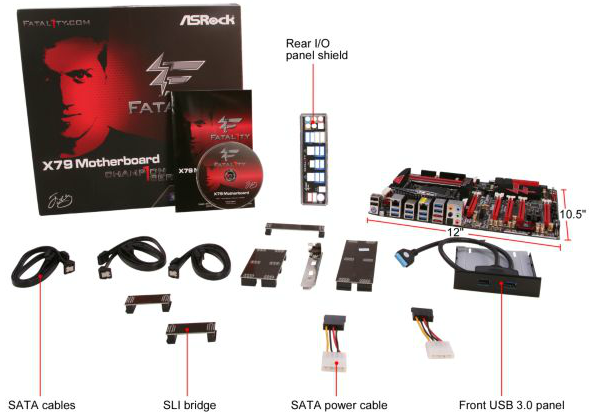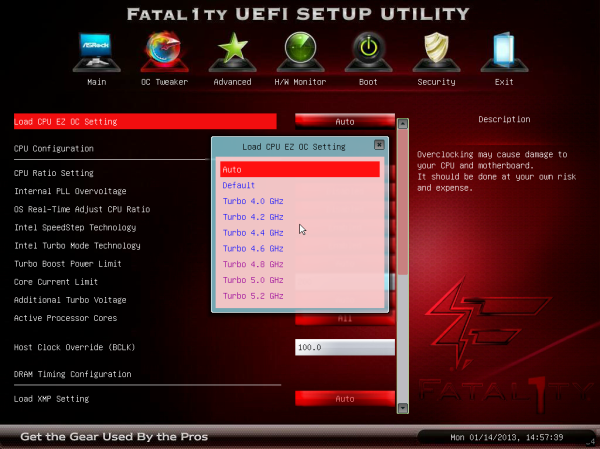ASRock Fatal1ty X79 Champion and X79 Professional Review: From a Gamer to Gamers
by Ian Cutress on February 9, 2013 10:30 AM EST- Posted in
- Motherboards
- ASRock
- Fatal1ty
- X79
ASRock X79 Champion In The Box
With these high-priced system configurations, it is sometimes hard to predict what extras come with the package. Every motherboard manufacturer should be trying to give something special with their motherboard – either in terms of something we would actually use (WiFi/USB 3.0 combination box), a little gimmick that becomes part of a daily routine (a keychain or belt buckle), or some memorabilia (cloth bag with logo for carrying accessories, poster or a ‘do not disturb’ door sign). This is not always the case – if a product is stripped down to be as cheap as possible but still have high end features, we may not take away more than a couple of SATA cables. A $1.50 keychain in every box might mean an extra $5 on the box cost, resulting in pricing the motherboard out of the market. The only SKU that gets free reign are the ultimate high end models (Z77X-UP7, Rampage IV Extreme, X79 Extreme11), but seeing as the Champion is the high end X79 gaming model from ASRock, should we be expecting anything special, such as a Fatal1ty branded lanyard or stickers?
In the X79 Champion, we get the following:
Driver CD
User Manual
Rear IO Shield
Six SATA Cables
Two Molex to SATA Power Cables
Two 2-slot Rigid SLI Bridges
One 3-slot Rigid SLI Bridge
One 2-slot Rigid 3-way SLI Bridge
One 3-slot Rigid 3-way SLI Bridge
USB 3.0 Front Panel with Rear Bracket included

There is nothing Fatal1ty branded (not even the SLI bridges or USB 3.0 front panel), but a wide selection of everything in a standard motherboard package. Six out of ten SATA cables is a reasonable number, but I wonder how many users will be needing molex to SATA power cables when they are spending $300+ on a motherboard and possibly $550+ on a CPU? Actually what I am more concerned about is the number of SLI bridges included. A total of five across four sizes for any NVIDIA combination scenario is a bit silly, and probably adds $10+ to the overall cost of the motherboard. AMD got it right with a standard connector and insisting all of its partners include one in the box of every card (not that all of them do), rather than putting the emphasis on the motherboard manufacturers. In retrospect, by doing it this way, NVIDIA sells more SLI bridges. This motherboard package only needs two – a 4-way SLI bridge for PCIe 1/2/4/5, and a 3-way SLI bridge for 1/3/5.
ASRock X79 Champion Overclocking
Experience with ASRock X79 Champion
Recent overclocking attempts with ASRock boards have been overtly successful when isolated purely by the BIOS. The amount of automatic overclocking options has been plentiful, and the layout of the BIOS makes it amenable to adjusting voltages, VDroop and clock speeds. The downside is often the overclock options in the operating system, which are varied in their usefulness such that there are no automatic options, and manual options are enabled only after booting into the OS and when a program is running.
Unfortunately we also have another issue – the 3960X we have used in our overclocking tests since November 2011 is not running at its best. After using it for several small extreme overclocking sessions (5.2+ GHz), it now requires more voltage to get to similar clocks at the beginning of its life (e.g. 1.45V for 4.6 GHz now rather than 1.40 V). In the grand scheme of things this is not too bad – if this 3960X was a poor sample to begin with, it would have showed these traits. This just means that the OC results for this review should not be directly compared to other X79 reviews, as we hit the ambient temperature cooling limitations quicker such that the system automatically reduces clock speeds.
Overall the overclocking experience through the BIOS was easy. Keeping track of what the automatic OC options did helped shape how the manual overclocking went, especially in terms of load line calibration and power limits. At the high voltages and speeds, the temperatures caused the system to automatically reduce the multiplier rather than overheat, suggesting that a fine tune is needed for the optimum speed.
Methodology:
Our standard overclocking methodology is as follows. We select the automatic overclock options and test for stability with PovRay and OCCT to simulate high-end workloads. These stability tests aim to catch any immediate causes for memory or CPU errors.
For manual overclocks, based on the information gathered from previous testing, starts off at a nominal voltage and CPU multiplier, and the multiplier is increased until the stability tests are failed. The CPU voltage is increased gradually until the stability tests are passed, and the process repeated until the motherboard reduces the multiplier automatically (due to safety protocol) or the CPU temperature reaches a stupidly high level (100ºC+).
Our test bed is not in a case, which should push overclocks higher with fresher (cooler) air. We also are using Corsair’s H80i with a push-pull fan arrangement. This is a 120mm double-width radiator liquid cooler, designed to mimic a medium-to-high end air cooler.
Automatic Overclock:
The X79 Champion offers seven automatic overclocking options in the BIOS under the CPU EZ OC Menu:
Each of these options was stress tested under our normal setup conditions, with the following results:
As we moved through the options, the system increased the power and current limits on the board, along with applying a first a CPU voltage offset, then a fixed voltage value. The LLC was also adjusted from Level 5 (low) up to Level 1 (constant). Unfortunately the results were not that great, with the CPU and system maxing out at 4.4 GHz under these settings.
Manual Overclock:
From the automatic overclocking, the system was set to a power limit of 500W, a current limit of 300A, PLL Overvoltage turned on, and the LLC set to Level 1. In line with previous X79 reviews, we set the CPU to the 42x multiplier for 4.2 GHz, and the BIOS voltage at 1.350 volts. When the system passed the stress test, the multiplier was increased – if it failed, the voltage was increased. Repeat until cooked.
Our system managed to pass the stress tests at 4.7 GHz with an alarmingly high 1.525 volts set in the BIOS. At 4.8 GHz the system passed both tests, although when closing PovRay the system BSODed. At that temperature, the system was already starting to throttle the CPU multiplier, as shown by the irregular increase in the PovRay score. With these results, 4.5 GHz seems a happy spot to be in.













71 Comments
View All Comments
scaramoosh - Saturday, February 9, 2013 - link
I don't get why they release these, he's done nothing in half a decade and no self respecting person who knows anything about hardware would buy because of a so called Celeb name being put on it. It just acts as a warning sign for me...Tech-Curious - Saturday, February 9, 2013 - link
I admit that I didn't really know who Fatal1ty was before I read this article, apart from a vague recognition that the silly leet-speak moniker belonged to someone in gaming.And I agree with your general point, that such branding on a motherboard is silly.
But all of that said, if the guy really did win $500,000 in gaming competitions, that's a pretty big deal. Now that he's retired, if companies (or, perhaps, their customers) are dumb enough to give him a comfortable living through lame marketing campaigns like ASRock's, then more power to him.
Wouldn't touch the motherboard with a ten foot pole, but I can't blame the endorser for accepting the check.
Nice review.
Beenthere - Saturday, February 9, 2013 - link
The "Fatality" branded mobos are just Asrocks high end models. They are pretty good mobos.The issue is the marketing is dumb as are those who buy products based on this type of marketing. Clearly enough Asrock customers voiced their displeasure with the crap marketing of John Boy all over the place as Asrock removed his image from the BIOS and allows people to disable his face on the boot screen too. Owner reviews in any PC hardware forum show a lot of folks unhappy with the marketing - not the mobos.
Samus - Saturday, February 9, 2013 - link
I've owned a few Fatal1ty products and all of them have been really good quality, especially the headsets and mice.I don't think the guy will put his name on crap. And I don't think companies making crap want his name on their product, since it isn't cheap to put his name on that product and if it backfires, it'll cost them.
Omega215D - Sunday, February 10, 2013 - link
The Creative gaming mice with his name on it weren't all that great performance-wise and were pretty much crap compared to stuff from Logitech in those days. The sound cards weren't anything special as well but cost much more than it should.hp79 - Sunday, February 10, 2013 - link
I had a crap fatality branded geforce 8800gs or something, and it was uber crap. I got this as a repalcement when my 7900gs died. My 8800gs had no fan control, so it was running at 100% all the time. Very loud graphics card. I sold it after couple days.I really don't see a point branding it with a person maybe because I don't even know or care who this dude is.
StevoLincolnite - Sunday, February 10, 2013 - link
I had a Fatal1ty 990FX board in my old AMD rig, was incredibly solid and overclocked like a champ.Unfortunately, I needed more performance and decided to go with a Military themed build so went with the Asus Sabertooth X79 board, which other than slightly noisy motherboard fans is solid too.
aguilpa1 - Tuesday, February 12, 2013 - link
Yea, I still have a Fatal1ty Xfi audio card but I didn't buy because it had his handle on it but because at the time it was the only Xfi model that offered the break out box front panel.JonnyDough - Friday, February 15, 2013 - link
It tells us that it's a high-end board though. Just as it did for Creative and whoever else. It's like putting Ferrari on a monitor....LOLFlunk - Saturday, February 9, 2013 - link
I agree. I refuse to buy anything branded with that name on principle. I'm not paying extra just for branding from someone I don't even respect or care about. Hell, I would rather have a Michael Jordan* branded motherboard than a one of these.*No, I do not like Basketball.